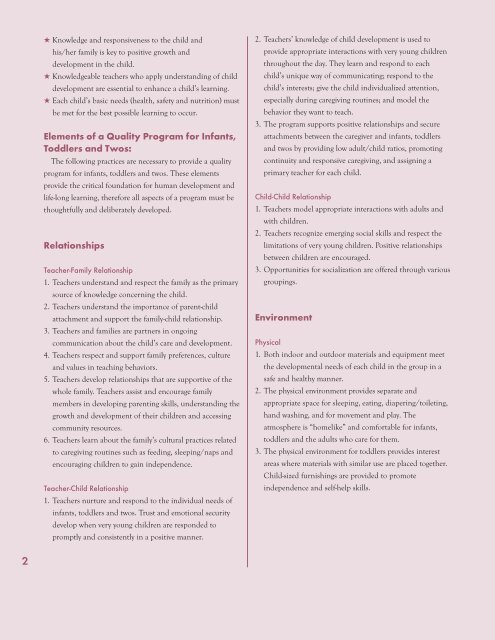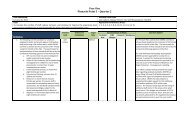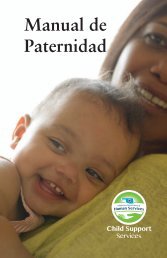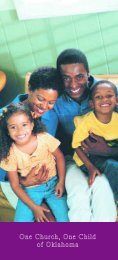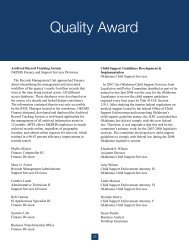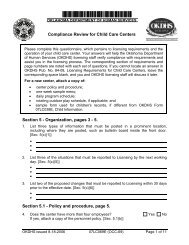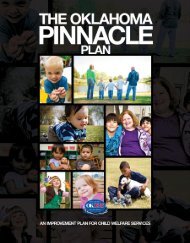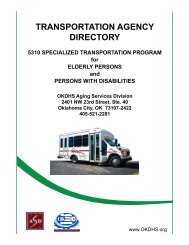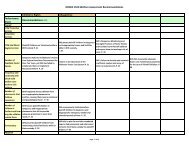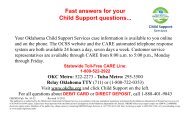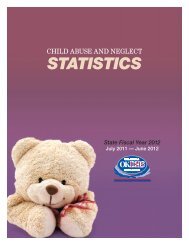Oklahoma Early Learning Guidelines for Infants, Toddlers and Twos
Oklahoma Early Learning Guidelines for Infants, Toddlers and Twos
Oklahoma Early Learning Guidelines for Infants, Toddlers and Twos
You also want an ePaper? Increase the reach of your titles
YUMPU automatically turns print PDFs into web optimized ePapers that Google loves.
2<br />
★ Knowledge <strong>and</strong> responsiveness to the child <strong>and</strong><br />
his/her family is key to positive growth <strong>and</strong><br />
development in the child.<br />
★ Knowledgeable teachers who apply underst<strong>and</strong>ing of child<br />
development are essential to enhance a child’s learning.<br />
★ Each child’s basic needs (health, safety <strong>and</strong> nutrition) must<br />
be met <strong>for</strong> the best possible learning to occur.<br />
Elements of a Quality Program <strong>for</strong> <strong>Infants</strong>,<br />
<strong>Toddlers</strong> <strong>and</strong> <strong>Twos</strong>:<br />
The following practices are necessary to provide a quality<br />
program <strong>for</strong> infants, toddlers <strong>and</strong> twos. These elements<br />
provide the critical foundation <strong>for</strong> human development <strong>and</strong><br />
lifelong learning, there<strong>for</strong>e all aspects of a program must be<br />
thoughtfully <strong>and</strong> deliberately developed.<br />
Relationships<br />
TeacherFamily Relationship<br />
1. Teachers underst<strong>and</strong> <strong>and</strong> respect the family as the primary<br />
source of knowledge concerning the child.<br />
2. Teachers underst<strong>and</strong> the importance of parentchild<br />
attachment <strong>and</strong> support the familychild relationship.<br />
3. Teachers <strong>and</strong> families are partners in ongoing<br />
communication about the child’s care <strong>and</strong> development.<br />
4. Teachers respect <strong>and</strong> support family preferences, culture<br />
<strong>and</strong> values in teaching behaviors.<br />
5. Teachers develop relationships that are supportive of the<br />
whole family. Teachers assist <strong>and</strong> encourage family<br />
members in developing parenting skills, underst<strong>and</strong>ing the<br />
growth <strong>and</strong> development of their children <strong>and</strong> accessing<br />
community resources.<br />
6. Teachers learn about the family’s cultural practices related<br />
to caregiving routines such as feeding, sleeping/naps <strong>and</strong><br />
encouraging children to gain independence.<br />
TeacherChild Relationship<br />
1. Teachers nurture <strong>and</strong> respond to the individual needs of<br />
infants, toddlers <strong>and</strong> twos. Trust <strong>and</strong> emotional security<br />
develop when very young children are responded to<br />
promptly <strong>and</strong> consistently in a positive manner.<br />
2. Teachers’ knowledge of child development is used to<br />
provide appropriate interactions with very young children<br />
throughout the day. They learn <strong>and</strong> respond to each<br />
child’s unique way of communicating; respond to the<br />
child’s interests; give the child individualized attention,<br />
especially during caregiving routines; <strong>and</strong> model the<br />
behavior they want to teach.<br />
3. The program supports positive relationships <strong>and</strong> secure<br />
attachments between the caregiver <strong>and</strong> infants, toddlers<br />
<strong>and</strong> twos by providing low adult/child ratios, promoting<br />
continuity <strong>and</strong> responsive caregiving, <strong>and</strong> assigning a<br />
primary teacher <strong>for</strong> each child.<br />
ChildChild Relationship<br />
1. Teachers model appropriate interactions with adults <strong>and</strong><br />
with children.<br />
2. Teachers recognize emerging social skills <strong>and</strong> respect the<br />
limitations of very young children. Positive relationships<br />
between children are encouraged.<br />
3. Opportunities <strong>for</strong> socialization are offered through various<br />
groupings.<br />
Environment<br />
Physical<br />
1. Both indoor <strong>and</strong> outdoor materials <strong>and</strong> equipment meet<br />
the developmental needs of each child in the group in a<br />
safe <strong>and</strong> healthy manner.<br />
2. The physical environment provides separate <strong>and</strong><br />
appropriate space <strong>for</strong> sleeping, eating, diapering/toileting,<br />
h<strong>and</strong> washing, <strong>and</strong> <strong>for</strong> movement <strong>and</strong> play. The<br />
atmosphere is “homelike” <strong>and</strong> com<strong>for</strong>table <strong>for</strong> infants,<br />
toddlers <strong>and</strong> the adults who care <strong>for</strong> them.<br />
3. The physical environment <strong>for</strong> toddlers provides interest<br />
areas where materials with similar use are placed together.<br />
Childsized furnishings are provided to promote<br />
independence <strong>and</strong> selfhelp skills.


